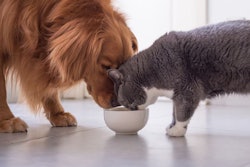
Since the pet food market weathered the Great Recession in 2008-2009 fairly well, better than most consumer goods categories, many people have called the market recession resistant or resilient. But now, as the entire world faces an unprecedented pandemic and resulting economic meltdown, a new question arises: Is pet food COVID-19 resistant?
Current sales are soaring, at least in the U.S., where data from Nielsen reveals heady growth rates of 37.5% for dog food for the week ending March 14, 2020, over the same week in 2019 – followed by a whopping 54.7% for the week ending March 21. Similarly, cat food experienced gains of 38.7% and 52.8% for the respective weeks. Individual pet food companies, such as Blue Buffalo (General Mills) and “I and love and you,” have also reported soaring sales in March, which is when the pandemic began spreading throughout the U.S. and people in many parts of the country were encouraged or ordered to stay home.
While such panic buying and pet food hoarding are not likely to last, Packaged Facts is still projecting 4% growth overall for the U.S. pet food market in 2020 – one of the few bright spots in an otherwise gloomy projection: The overall U.S. pet care industry could decline by as much as 17% this year. (Cat litter is the other positive category – and this cat owner is doing her part to keep those sales humming!)
US pet food market still affected by COVID-19 fallout
The 2020 outlook for pet food is not as rosy as it once was. “Likely to dampen pet food dollar sales after short-term distribution disruptions work themselves out, nonetheless, is a trade down to lower-cost private-label and value brands in a recessionary era,” said a new Packaged Facts report, U.S. Pet Market Outlook 2020-2021. That means sales growth of only 4% versus the 6% the market research firm originally projected, pre-COVID-19.
That’s still a much more positive story than the 17% sales decrease projected for the overall pet products and services market, a complete reverse from 5% growth expected pre-pandemic. With pet food and treats accounting for 39% of the overall U.S. pet care market in 2019, the 2020 pet care outlook might be even worse without pet food’s projected growth.
Packaged Facts does expect a rebound in 2021 and beyond, both for the overall pet care market and pet food. For total pet care, sales are projected to grow 12.4% in 2021, followed by another 10% increase in 2022, then 8% and 6.4% in 2023 and 2024, respectively. Pet food sales are projected to increase at a 5% compound annual growth rate through 2024 (going back to 2019; the 5% rate is just below the 5.5% projected pre-COVID-19).
Pet food acquisitions continue, even speak to crisis
Another positive for pet food: Acquisitions are still happening. For example, Dane Creek Capital Corp. added to its portfolio of raw pet food brands by buying Tollden Farms, a Canadian manufacturer of frozen foods, announced March 27. Then, a few days later, Nestlé Purina PetCare announced that it’s acquiring Lily’s Kitchen, a UK producer of premium wet and dry natural dog and cat foods. While both deals were likely in the works for some time, it’s telling that the purchasers decided to proceed with the acquisitions despite the uncertain times and economy.
Mark Warren, chairman and CEO of Dane Creek, addressed the new reality and how it played into his company’s decision. “Over the last several weeks, we have witnessed a dramatic shift in consumer buying habits, many of which we believe will outlast the current health crisis being faced by Canadians,” he said. “While we are not naive about the long-term impact on the overall Canadian economy, we also believe the sudden and significant growth in the ‘stay at home economy’ witnessed recently will outlast the current economic turmoil and benefit the pet industry specifically. Pet ownership is central to that economy as people stay close to home and nest. Dogs and cats are family and as such play an important role in reducing overall stress in these tougher times.”
Indeed, Packaged Facts and other market sources believe pet ownership will stay solid, perhaps even increase, during this crisis, even as many pet owners confront loss of jobs and income. That’s one of the key reasons for its bullish projections for a pet market rebound in 2021 and beyond.
What lies ahead? Look to Chinese pet food company
For a near-term forecast on how pet food will continue to fare during and beyond the pandemic, perhaps we can look to where it all began: China. Pet Fair Asia recently posted an interview with Hao Zhongli, founder of Yantai China Pet Foods Co. Ltd. Its main brand, Wanpy, includes foods and treats for dogs and cats, sold in 50 markets around the world. The company has 14 pet food factories globally (though most are in China) and 16 subsidiaries, according to its website.
Hao said the company was able to resume work on February 10, after most of China had been shut down in January, but many “non-local front-line” production workers (presumably in parts of China still under lockdown or restrictions?) have been affected by the coronavirus outbreak and are still unable to return to work, restricting the company’s overall production capacity. This has mainly affected its export business, he said.
However, Yantai’s domestic business has remained strong and mostly unaffected, Hao said. “Some offline pet stores were unable to operate during the outbreak, which caused a certain impact on offline pet retail in China, but pet food is a rigid demand for families with pets, and the total demand will not be affected by the closure of the stores. Therefore, during the outbreak period, the domestic online business grew rapidly and the volume continued to increase, making up for some of the sales in the offline retail market.”
The pandemic has had no effect, according to Hao, on Yantai’s production facilities in the U.S., Canada, New Zealand and Cambodia; in fact, the company expects an increase in production orders for those factories even above original projections. I was unable to discern where its U.S. factory is located, but going by Hao’s optimistic outlook, presumably it’s not close to one of the current or looming COVID-19 epicenters?
The interview provides some details and insights on how Yantai kept operations going during the height of the outbreak in China. Looking ahead, Hao’s projections for his company and the domestic market are positive. “The number of pets, the concept of keeping pets and the proportion of eating professional food are rising rapidly. Although the outbreak has affected the performance of offline stores to some extent, the government has also given policy support to the affected industries, and online sales have also grown rapidly,” Hao said. The overall impact of the pandemic on the Chinese pet food industry is limited, in his view; he believes the market will rebound and enjoy new growth.
View our continuing coverage of the coronavirus/COVID-19 pandemic.


















